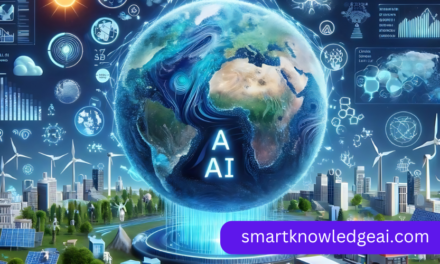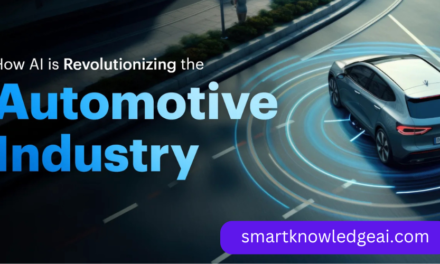The world is facing pressing environmental challenges, from climate change and deforestation to water scarcity and pollution. These issues require innovative solutions that go beyond traditional approaches, and Artificial Intelligence (AI) is emerging as a key player in addressing these global concerns. With its capacity to analyze vast datasets, detect patterns, and make precise predictions, AI is becoming an invaluable tool for creating sustainable solutions. This blog will explore the ways in which AI contributes to environmental sustainability, highlight its pros and cons, and discuss potential future applications.
How AI in Environmental Sustainability is Supporting
- Climate Change Modeling and Prediction: One of the most significant applications of AI in sustainability is its role in climate modeling. AI-powered algorithms can analyze vast amounts of historical climate data and current trends to predict future climate conditions with remarkable accuracy. These models help scientists and policymakers understand potential scenarios, forecast natural disasters, and develop strategies to mitigate the effects of climate change. For example, machine learning models are used to simulate the impact of rising temperatures on specific regions, allowing for targeted climate action plans.
- Energy Optimization: AI technologies play an important role in optimizing energy consumption for both residential and industrial applications. Smart grids, driven by AI, can monitor energy usage patterns, predict peak times, and allocate energy more efficiently to reduce waste. AI also assists in renewable energy management by forecasting solar and wind energy production, ensuring a steady supply of clean energy.
- Wildlife Conservation: AI is being utilized for wildlife monitoring and protection efforts. Machine learning models can analyze images and video data captured by camera traps to identify animal species, track migration patterns, and monitor population health. This helps conservationists make informed decisions about protecting endangered species and their habitats. Additionally, AI-driven systems can detect poaching activities in real-time, enabling rapid response to protect vulnerable wildlife.
- Precision Agriculture: AI-powered tools are transforming agriculture by enabling more efficient and sustainable farming practices. Through data analysis, AI helps farmers monitor soil health, predict crop yields, and detect signs of disease or pest infestations early. This allows for targeted interventions, reducing the use of water, fertilizers, and pesticides, which in turn minimizes environmental damage.
- Pollution Control: AI models can help monitor air and water quality, providing real-time data and predictive analysis to detect pollution sources and forecast potential contamination events. By analyzing data from sensors and satellite imagery, AI systems can identify trends and alert authorities before pollution reaches critical levels. This proactive approach can help mitigate the impact of industrial emissions, urban waste, and other pollutants on the environment.
The Pros of Using AI for Environmental Sustainability
- Increased Efficiency: AI-driven systems can process and analyze data far more quickly and accurately than human capabilities allow. This increases efficiency in areas like energy management, waste reduction, and resource allocation, leading to more sustainable practices.
- Scalable Solutions: AI can be scaled to address environmental issues globally. Whether monitoring deforestation in the Amazon rainforest or tracking urban air quality, AI systems can operate on large scales to provide solutions that impact millions of people.
- Early Detection and Prevention: One of the strongest advantages of AI is its predictive capability. By identifying potential environmental threats before they become severe, AI allows for timely interventions. For instance, AI models used in agriculture can predict crop diseases early, preventing widespread damage and ensuring food security.
- Data-Driven Decision-Making: With AI’s ability to sift through massive datasets, decision-makers can rely on precise and data-driven insights to inform policies and strategies. This helps governments and organizations create more effective regulations and conservation programs.
- Continuous Improvement: Machine learning algorithms learn from new data, which means that AI-driven environmental models can improve over time. This continuous improvement allows for adaptive strategies that evolve as more data becomes available.

The Cons of Using AI for Environmental Sustainability
- High Energy Consumption: While AI can help optimize energy use, training machine learning models and operating large-scale AI systems often require significant computational power. Data centers that support these processes consume large amounts of electricity, which can contribute to carbon emissions unless they are powered by renewable energy.
- Data Privacy and Security Concerns: The data used for environmental monitoring often includes sensitive information, such as geolocation data and proprietary business information. Ensuring the privacy and security of this data is critical to maintaining trust and compliance with regulations.
- Dependence on Data Quality: The effectiveness of AI depends heavily on the quality of the data it is fed. Inaccurate or biased data can lead to faulty predictions and suboptimal outcomes, which can undermine environmental efforts. Continuous validation and quality control are necessary to maintain the reliability of AI systems.
- Economic Barriers: Implementing AI solutions can be expensive, which poses a challenge for developing countries that may lack the financial resources and technical expertise needed to adopt advanced technologies. This can widen the gap between nations with access to AI-driven sustainability solutions and those without.
- Ethical Considerations: The deployment of AI for environmental sustainability may involve ethical questions related to surveillance and privacy. For example, using drones and sensors to monitor wildlife and prevent poaching may raise concerns about the potential misuse of surveillance technology.
Future Applications of AI in Environmental Sustainability
- Circular Economy Models: AI has the potential to support circular economy models by optimizing waste management processes and resource recycling. Advanced AI systems can identify patterns in waste generation and suggest ways to repurpose materials more efficiently, reducing the need for new resources.
- Smart Urban Planning: AI can be leveraged for designing smart, eco-friendly cities by optimizing traffic flow, managing utilities, and planning sustainable infrastructure. These smart urban planning initiatives can reduce carbon footprints and make cities more livable.
- Carbon Footprint Tracking: AI systems can track and report the carbon emissions of industries and individuals. These tools could allow governments and organizations to better understand their impact and develop carbon reduction strategies that align with global sustainability goals.
- Biodiversity Preservation: AI can be employed to create digital replicas of ecosystems, helping scientists understand how different variables impact biodiversity. These models could provide insights into maintaining ecological balance and preventing species loss due to human activities.
Conclusion
Artificial Intelligence is proving to be a transformative force in the realm of environmental sustainability. By enabling data-driven solutions, predictive capabilities, and optimized resource management, AI is addressing some of the most pressing challenges of our time. However, it’s crucial to acknowledge the limitations and challenges associated with its use, such as energy consumption, data quality, and economic accessibility. Moving forward, stakeholders must work collaboratively to harness the potential of AI while ensuring its implementation is both ethical and inclusive.










